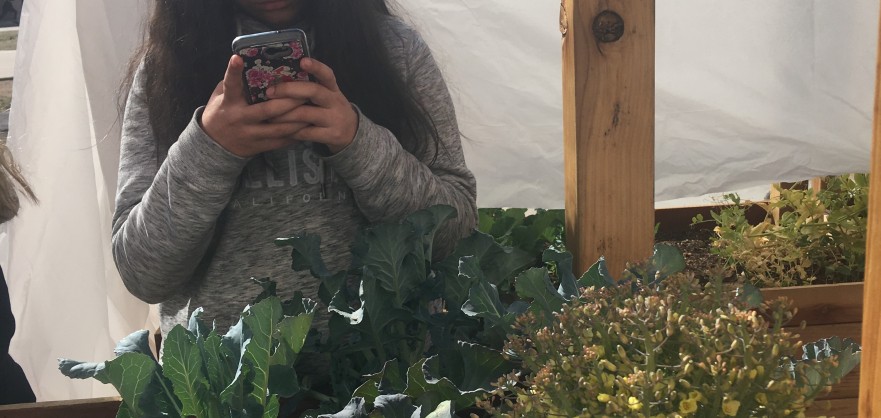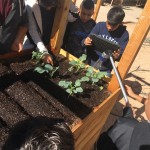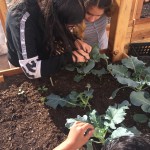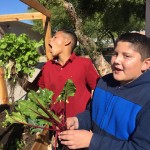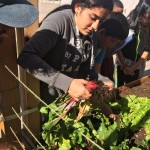When I learned we were assigned to work from home in March, my anxiety about the safety of my family lessened, and was immediately replaced with mild panic over whether our school garden* would be left to die.
At first I was hesitant to approach my principal with the question, since I was certain she was handling a shifting set of urgent decisions and policy implementations. I was afraid if I mis-timed my request to go water the plants, the answer would be no, since there would be no time to come to any other solution. The weather was cool, so I waited a few days… and was relieved to be told I could go to campus, with gloves and mask if I had them (I didn’t) and to report the exact areas I went and what I touched so they could be disinfected.
My first visit to the garden, I was overwhelmed with how empty it was. The plants were plugging along, living their lives, but the absence of smiling faces, hands in the dirt, and pencils on composition books filled my heart with sadness. As I mulched the plants, I thought of how the students would enjoy this task. I missed the small arguments over who got to use the watering wand, and whether they could take cilantro and lettuce to the guinea pigs in Ms. Dopudja’s room. I even missed the sound of the basketball game likely being played by the small group of boys who rushed through their garden journals.
- Watering, and watching watering
- Picking catepillars from broccoli
- The primal joy of beets.
- All this from the dirt.
When I asked to take on the school garden this year, my only hesitation was a fear that I wouldn’t follow through and do a good job, that I would get busy with other projects and not find the time to work on the garden, but the truth is, the garden came to drive the rhythm of our weeks. It provided a connection for my students, who are learning English, to our school community. They took pride in it, and I loved seeing the instant engagement it provided for many. Working with my students in the garden was by far the most rewarding part of my job this year, even though our harvests were uneven.
Now that the year is wrapping up, and I have spent eight lonely weeks in the garden, some lessons for education occur to me. These are a few.
Lesson 1: Ask, and you might receive. For years, one of my personal tenets as a teacher has been that if I see something I want or need, I will ask. People can tell me no, but sometimes they say yes. In general, if we don’t identify and express our wants and needs for our classrooms, how can we complain about not having them? This year, I had monetary and other support from administration, a nonprofit, several teachers and classified staff on campus, and even parents I had never met.
Lesson 2: A teacher’s goal is 100% student engagement. Plan for that, but if you get 70% engagement, and that engagement is inspiring and will clearly have a lasting impact on those students’ relationship with school, and you find yourself unwilling to deny them their fun and learning just because the other 30% runs away early to play basketball… maybe that’s okay, as long as you don’t give up on finding a way to get that 30% on board at some point!
Lesson 3: If the learning is authentic, you can let go a little bit of control, and things won’t dissolve into chaos. The first time I took my class out to see the new garden planters, a group of boys got very excited about the soil, and started plunging their arms deep into it, knocking a quantity of soil over the edge and onto the ground. I stopped them and let them know that the soil was important and not cheap! They walked inside filthy and maybe a little embarrassed. But in the spring, when the gardeners came to visit and put the same boys around a planter we were transitioning, and asked them to mix up the soil, eight boys stood around the planter elbow deep in the soil, churning it around happily, knocking almost none of it onto the ground. They planted dozens of watermelon seeds in there. It was a good day.
Lesson 4: Sometimes things don’t work out the way you planned, and there is little to be done about it. In early March, we harvested our beets, the last of our lettuce, some last bits of broccoli and a few radishes and carrots, and enjoyed a salad. We planted our corn and tomato seedlings, and some watermelon and sunflower seeds, among other things. Since the school closure, kids have trespassed onto the empty campus and pulled up the remaining broccoli plants, pulled any carrots that were mature enough to eat, and destroyed some of the sunflowers. Many seeds I planted to replace things we harvested never sprouted as the weather heated up. There were few potatoes in the potato harvest. But then again, the kids aren’t there to see or journal about all of that, and we didn’t plan on school closing, either. What’s to be done when you have done what you can?
When I went back to care for the garden that first time in March, I decided to share it with my students by posting garden updates on Instagram. The word “amateur” comes from the Latin word for “love,” and the videos are surely amateur in every sense. The quality is questionable, but they give me a way to send my love out to my students. Some of them have found the videos. Most haven’t. Pretty much like the rest of remote learning. My hope, though, is that the garden has still provided a lasting feeling of connection to our school.
*Our garden this year was funded by Kohl’s Mindful Me, through Phoenix Children’s Hospital. Brandon and Alyssa from Greenie’s Garden designed and built the planters and consulted throughout the year with us, even coming to work directly with the students in the spring. I am incredibly grateful for the learning and love my students and I experienced this year in the garden.

